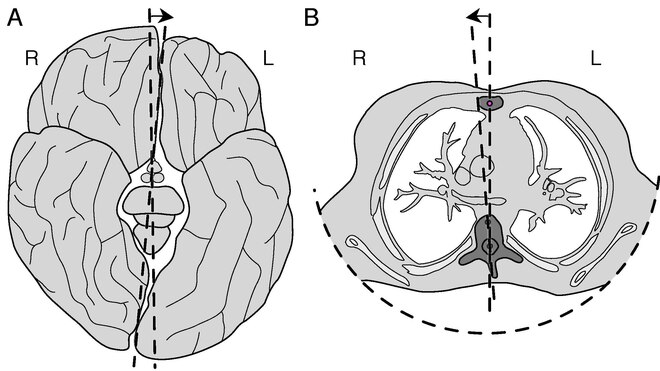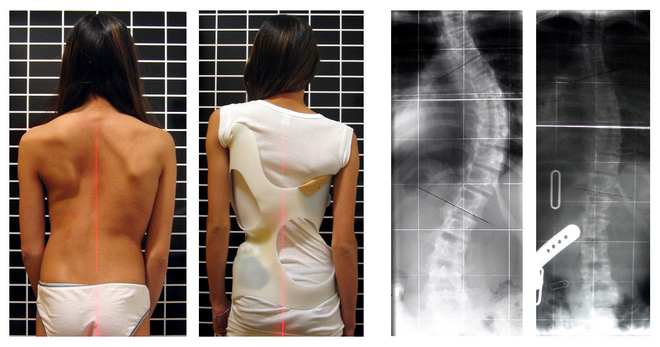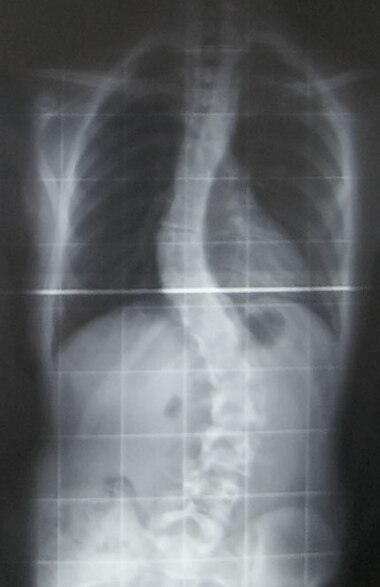Scoliosis
Scoliosis is a condition characterised by an irregular curvature of the spine, typically forming an S- or C-shape. This deviation can be observed across three dimensions. While mild scoliosis often does not cause significant issues, severe cases can impede breathing and movement, and adults frequently experience worsening pain over time.

Signs and Symptoms
Scoliosis symptoms include:
- Pain in the back at the site of the curve, potentially radiating to the legs.
- Respiratory or cardiac problems in severe cases.
- Constipation due to the curvature affecting the stomach and intestines.
Visual signs include:
- Uneven musculature on one side of the spine.
- Rib prominence or a prominent shoulder blade.
- Uneven posture.
- In severe cases, heart and lung problems.
- Calcium deposits in the cartilage endplate and sometimes in the disc itself.

Causes
Approximately 65% of scoliosis cases are idiopathic, meaning the cause is unknown. Genetic factors account for around 38% of the risk, while environmental factors account for 62%. Specific genes, such as CHD7, have been linked to idiopathic scoliosis, although the exact genetic contributors remain unclear.
Congenital scoliosis results from spinal malformations during early foetal development. Secondary scoliosis can arise from conditions like muscular dystrophy, cerebral palsy, or spinal muscular atrophy.

Diagnosis
Diagnosis often begins with a physical examination, including the Adams forward bend test. If scoliosis is suspected, weight-bearing X-rays of the full spine are taken to assess the severity and progression of the curves. The Cobb angle, which measures the degree of curvature, is the standard method for evaluating scoliosis.

Treatment
Observation and Bracing
Mild scoliosis may only require periodic observation. Bracing is often recommended for growing individuals with curves between 20° and 45°. The most commonly used brace is the TLSO, such as the Boston brace, which fits from the armpits to the hips and applies pressure to the spinal curves. Nighttime braces are also used but their effectiveness compared to conventional braces is still under study.


Surgery
Surgery is generally recommended for curves greater than 45°. The two main surgical approaches are anterior fusion and posterior fusion, often involving the use of metal instrumentation to correct the curvature. A newer procedure, anterior vertebral body tethering, may be appropriate for some patients.

Prognosis
A 50-year follow-up study published in the Journal of the American Medical Association in 2003 found that the overall physical and mental health of people with idiopathic scoliosis is comparable to the general population. The main factors influencing prognosis are the degree of curvature and the age of onset, with larger curves and curves in younger patients more likely to progress.
Epidemiology
Scoliosis affects about 2-3% of the population in the United States, with the age of onset typically between 10 and 15 years. The condition is more prevalent among females, likely due to earlier growth spurts during puberty.
History


The condition has been known since ancient times, with treatments evolving significantly in the 20th century. Early treatments included the Milwaukee brace and the Harrington rod, which have since been replaced by more advanced techniques and instrumentation.
Self-assessment MCQs (single best answer)
What is scoliosis characterised by?
What is the most common cause of scoliosis?
Which of the following is a common visual sign of scoliosis?
What percentage of scoliosis cases are idiopathic?
What is the standard method for evaluating scoliosis severity?
Which brace is most commonly used for growing individuals with scoliosis?
At what degree of curvature is surgery generally recommended for scoliosis?
Which of the following is NOT a potential symptom of severe scoliosis?
What is the typical age of onset for scoliosis?
Which historical figure was found to have severe scoliosis upon the discovery of their remains?
Dentaljuce
Dentaljuce provides Enhanced Continuing Professional Development (CPD) with GDC-approved Certificates for dental professionals worldwide.
Founded in 2009 by the award-winning Masters team from the School of Dentistry at the University of Birmingham, Dentaljuce has established itself as the leading platform for online CPD.
With over 100 high-quality online courses available for a single annual membership fee, Dentaljuce offers comprehensive e-learning designed for busy dental professionals.
The courses cover a complete range of topics, from clinical skills to patient communication, and are suitable for dentists, nurses, hygienists, therapists, students, and practice managers.
Dentaljuce features Dr. Aiden, a dentally trained AI-powered personal tutor available 24/7 to assist with queries and provide guidance through complex topics, enhancing the learning experience.
Check out our range of courses, or sign up now!


